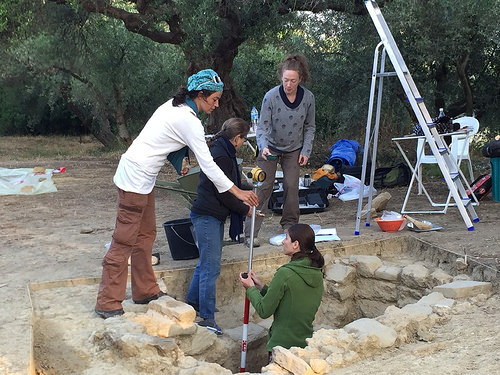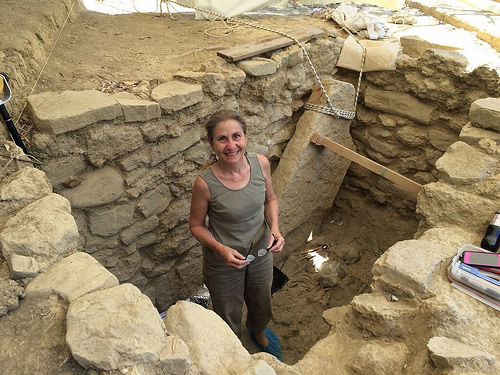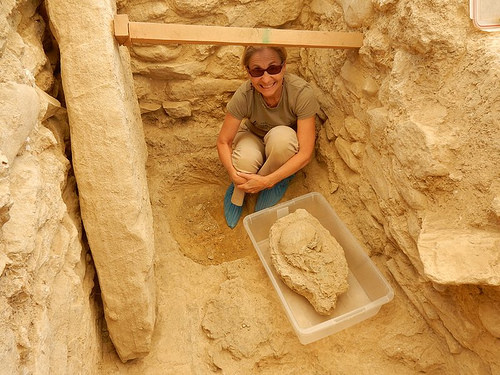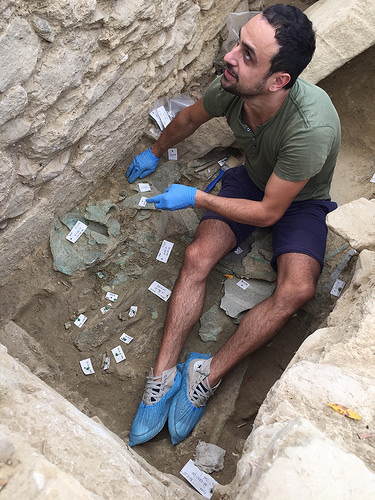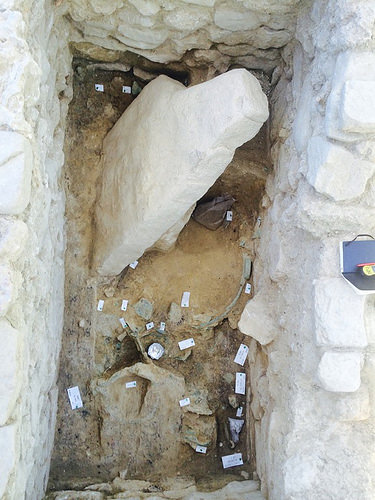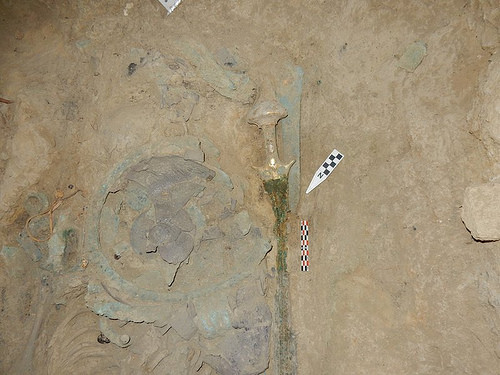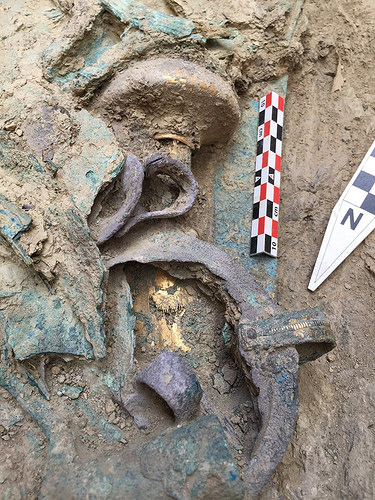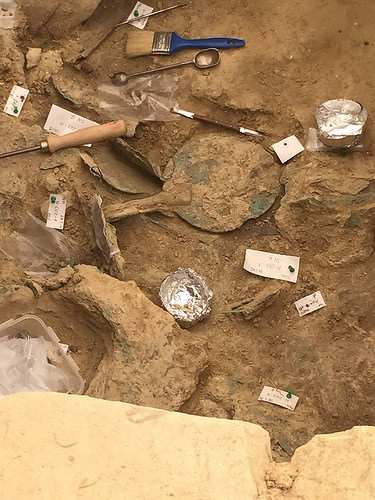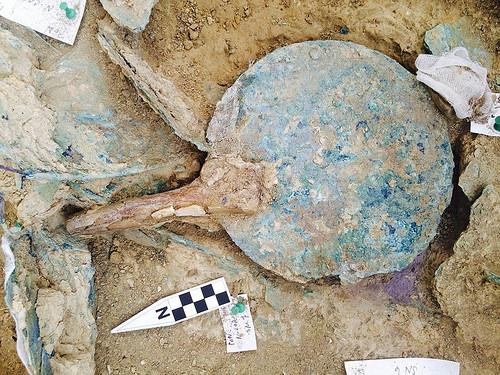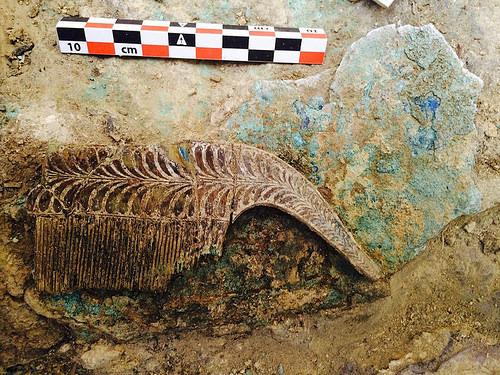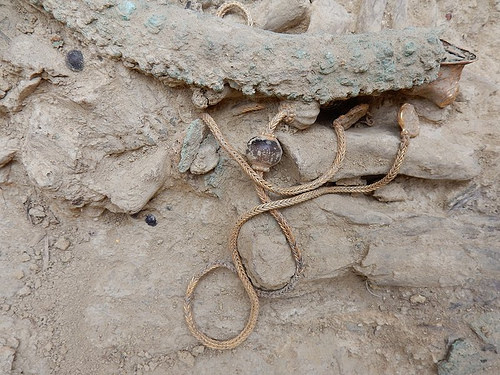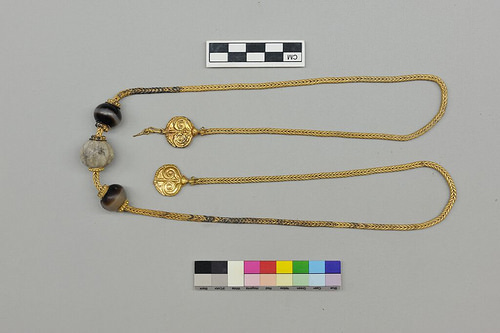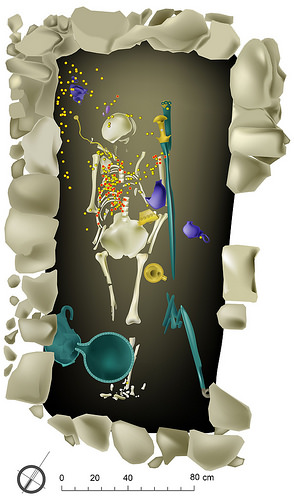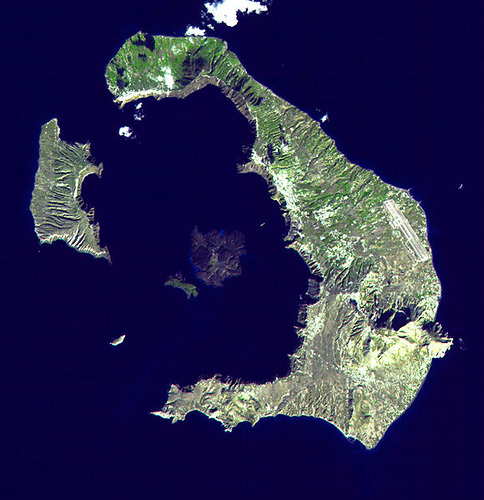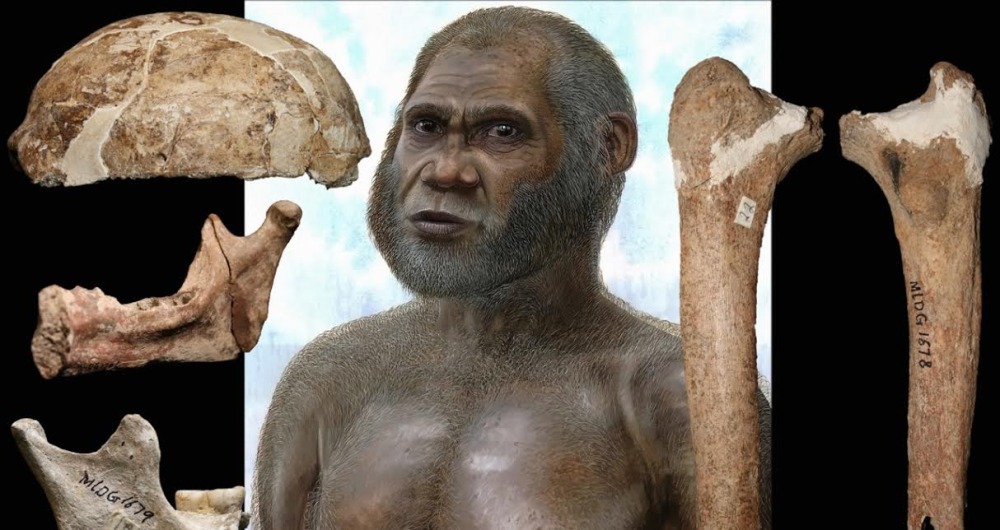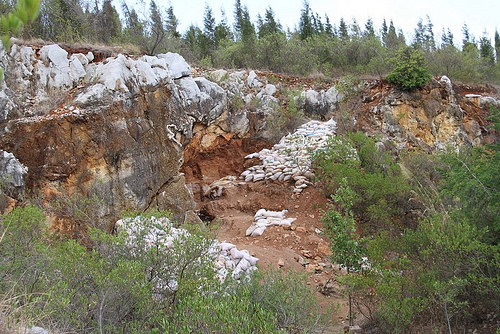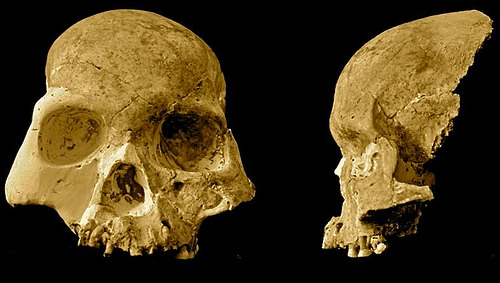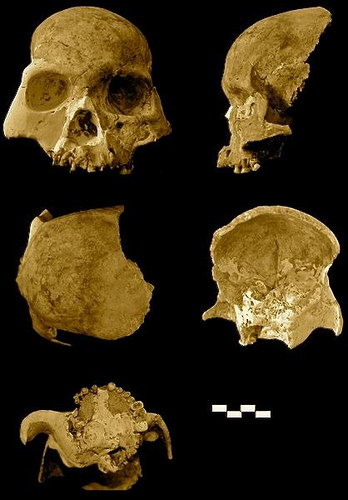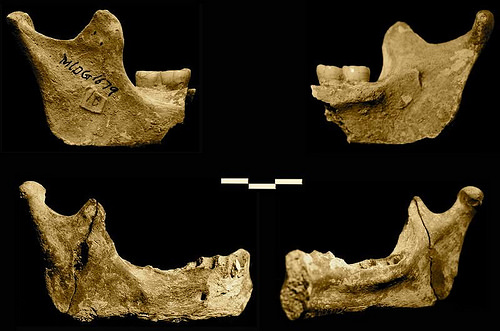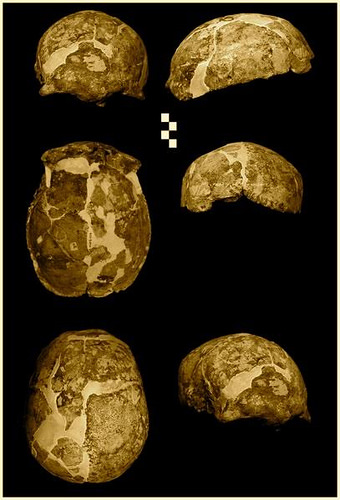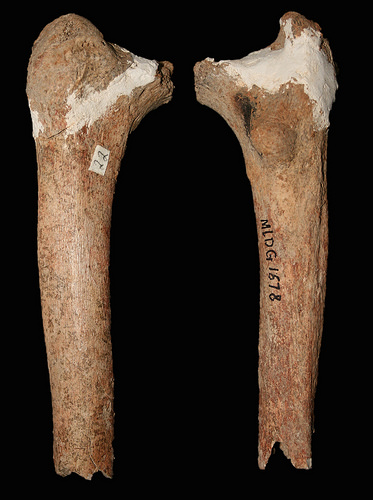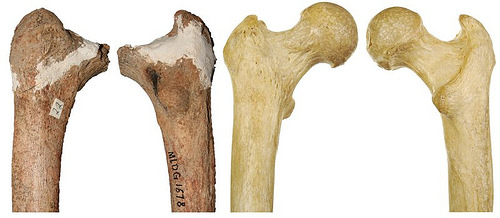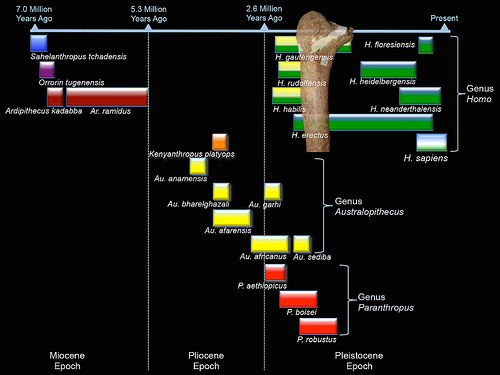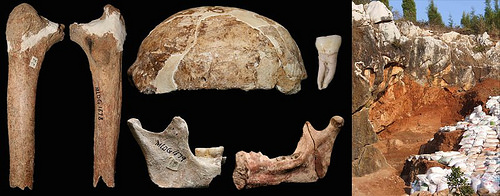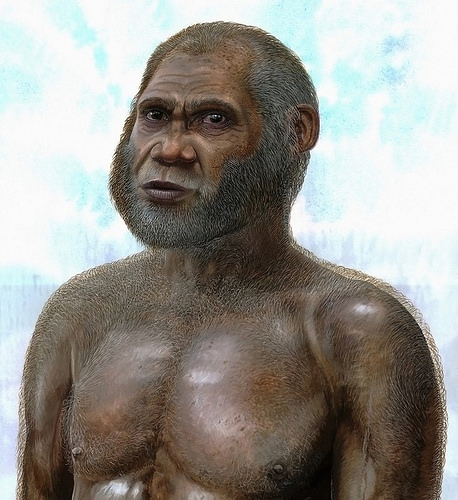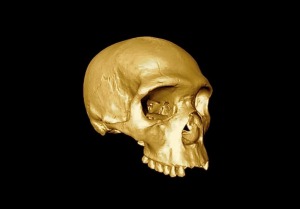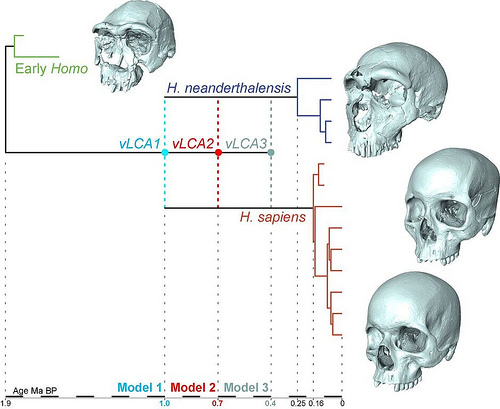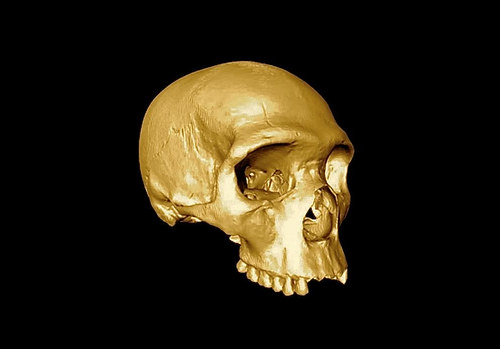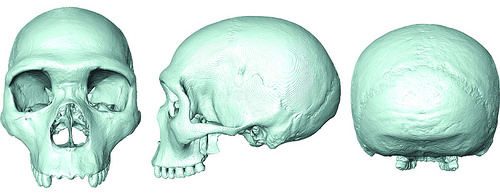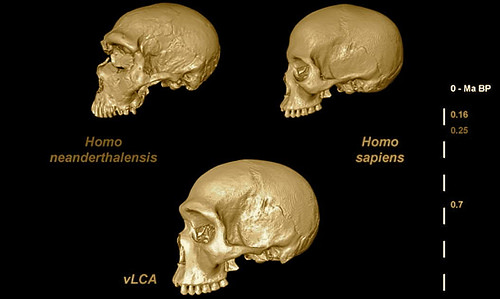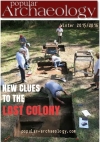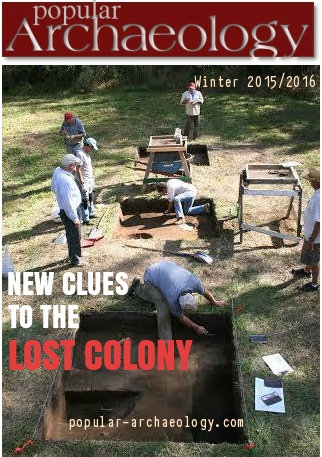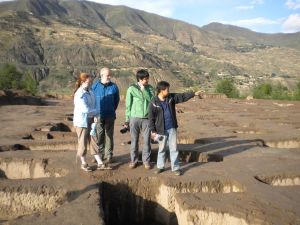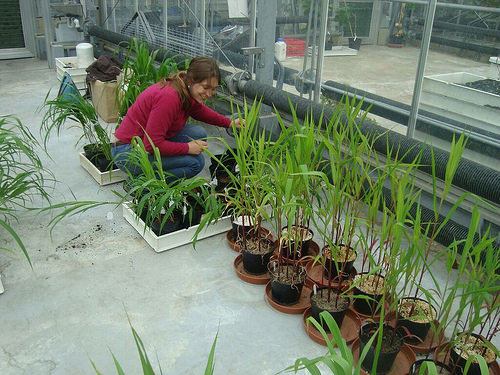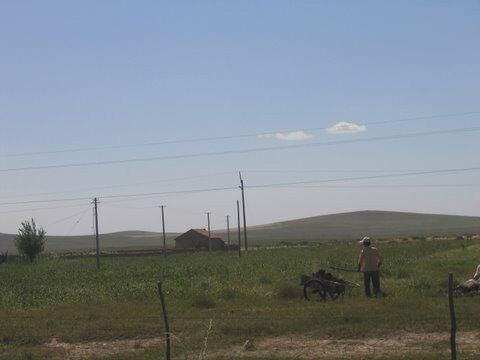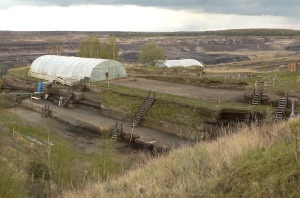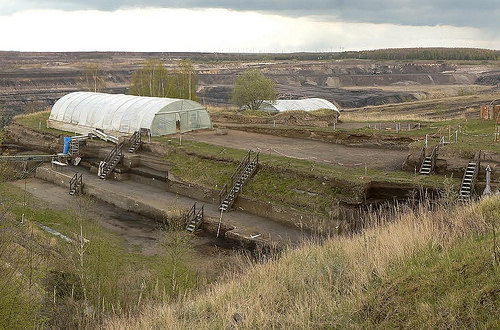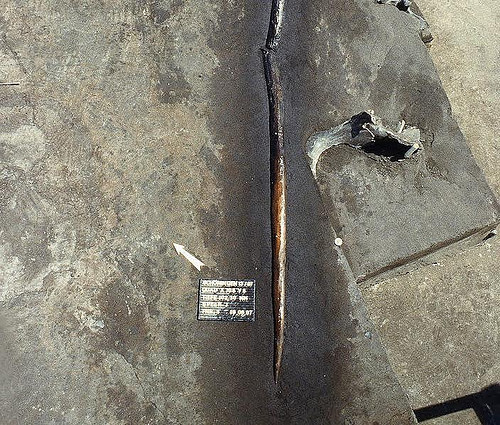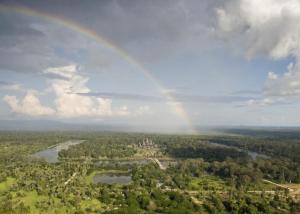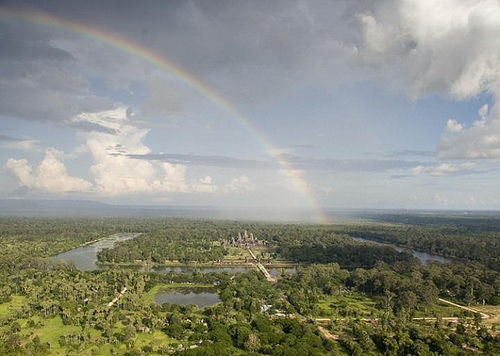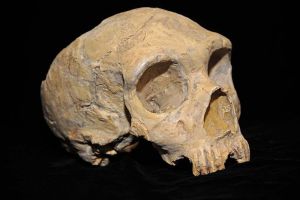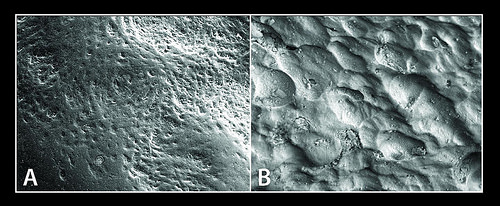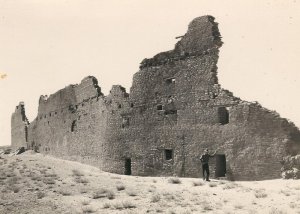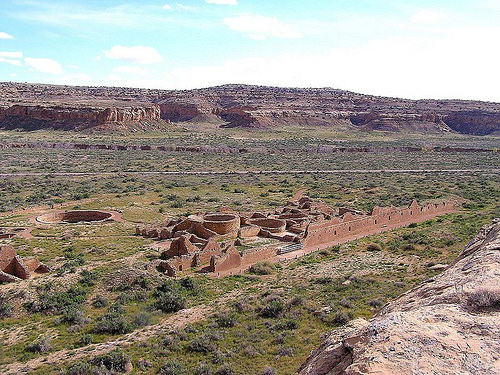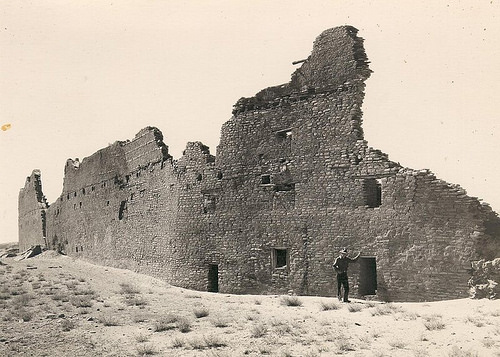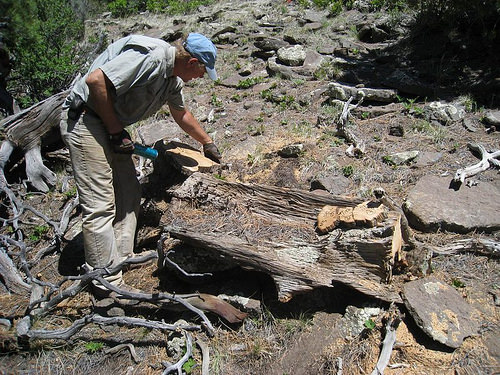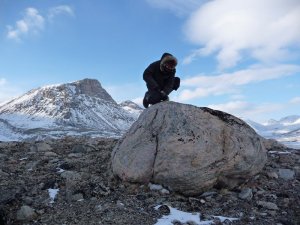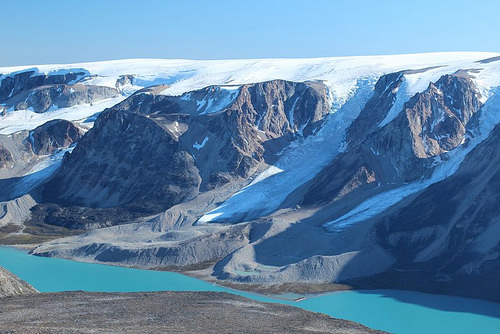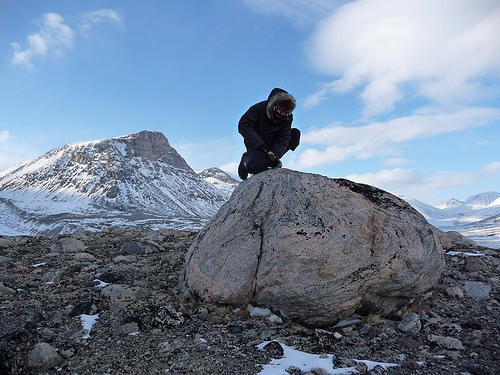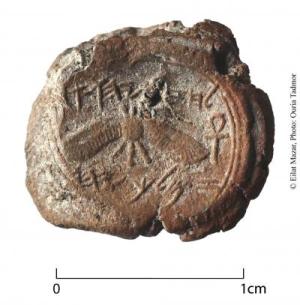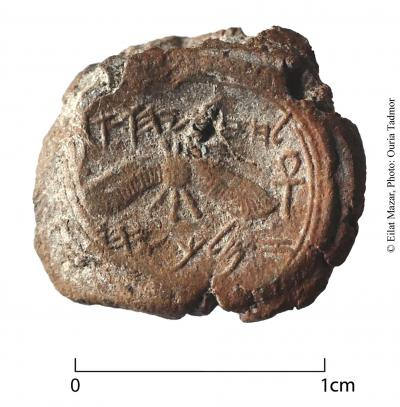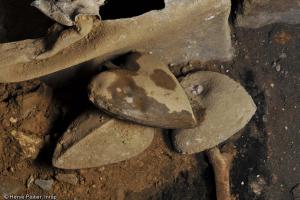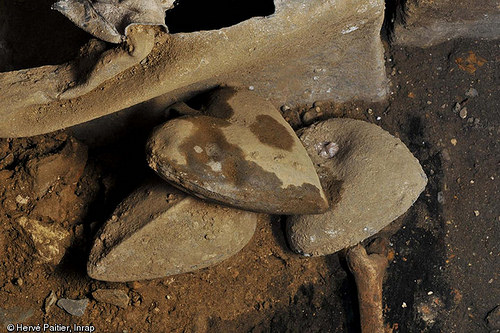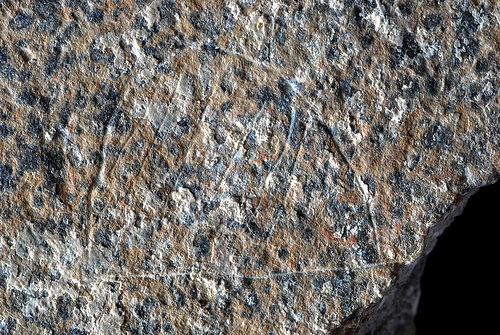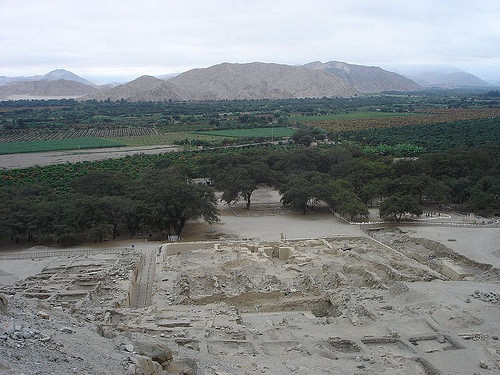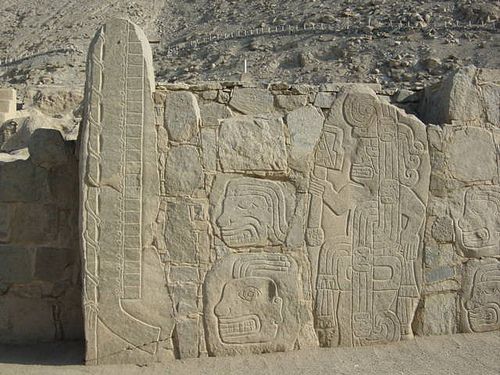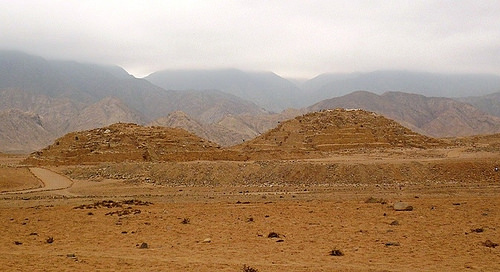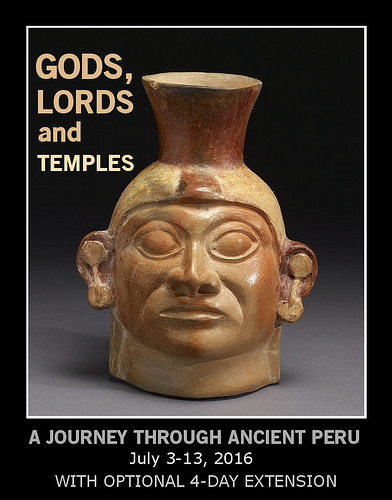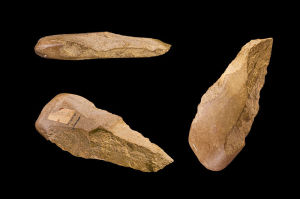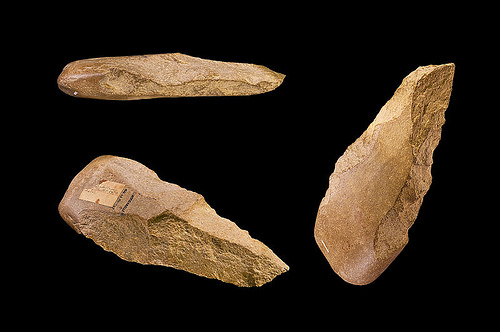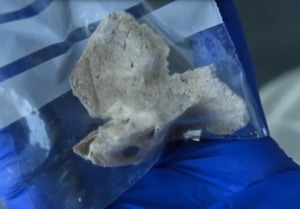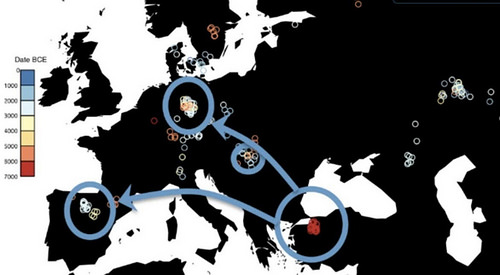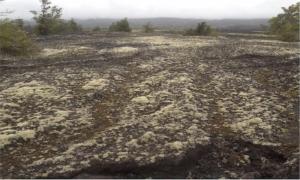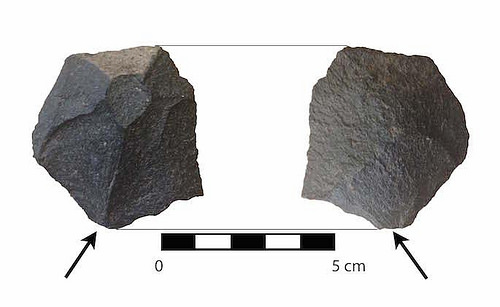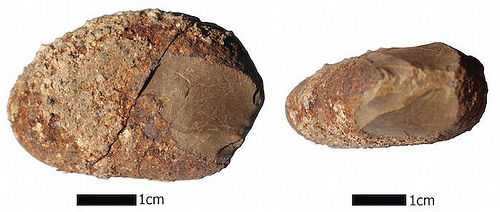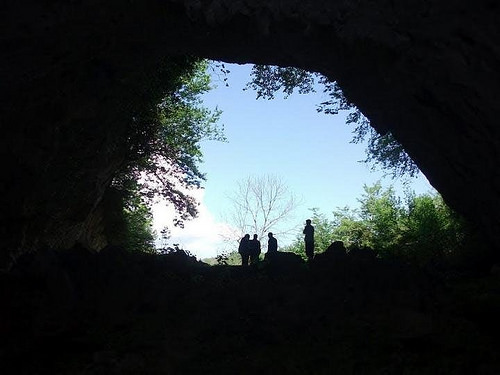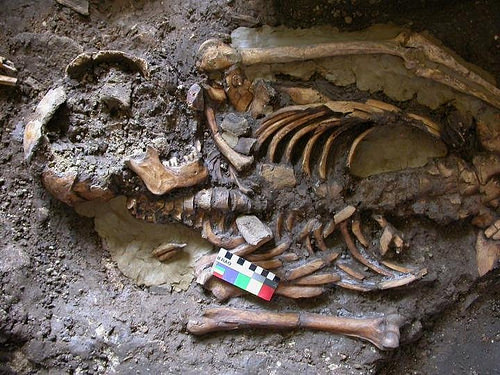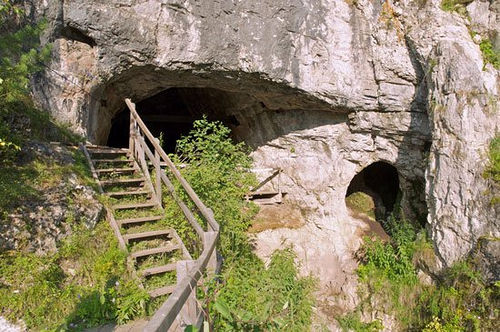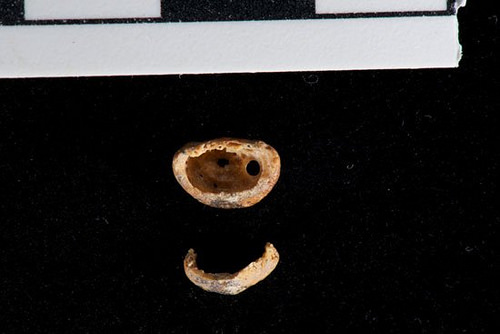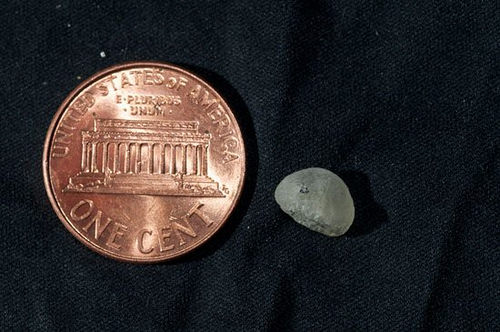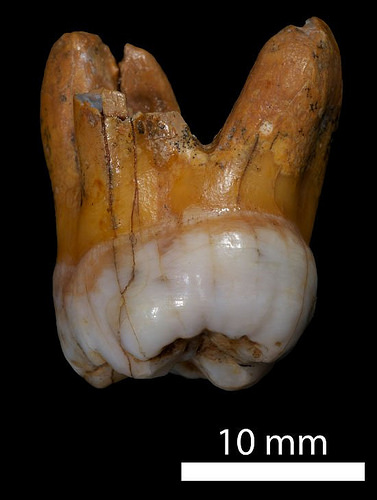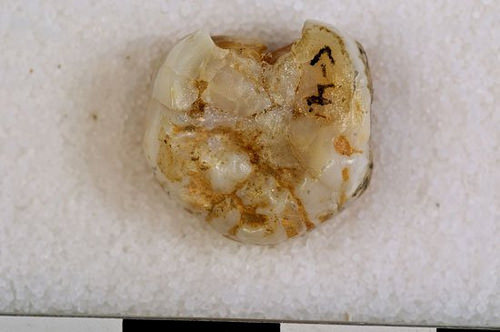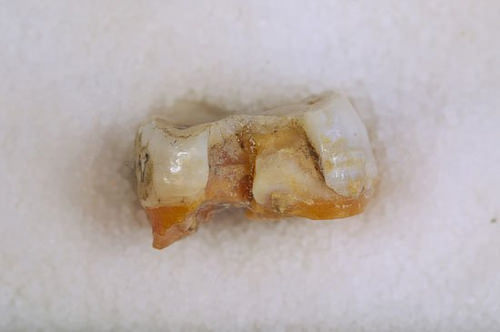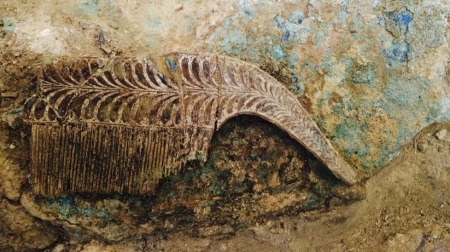
Excavating near the ancient site of Pylos in southwestern Greece, archaeologist Alison Fields sent a text message from her smartphone as soon as she knew she had encountered something worth shouting about. “I hit bronze,” she texted. The receiver, Sharon Stocker, knew what this meant. Stocker and her colleagues, some distance away, dropped everything and came running where Fields was excavating. Fields, an advanced graduate student with the University of Cincinnati and a key field excavation director at the site, along with coworker Flint Dibble, were already well beneath the surface within a stone-lined shaft tomb by this time, and Stocker, a senior research associate with the University of Cincinnati, was co-leading the team responsible for overall excavations in the area of the site.
It wasn’t long before the bronze encounter became a single, large bronze basin. But as they excavated, there was much more. Their efforts eventually led to the skeletal remains of an adult male and nearly 1500 more artifacts, some of the artifacts featuring rich iconography, and all associated with a single burial. Dated to about 1500 B.C. based on pottery shards found at the location, the shaft tomb and its contents have turned out to be, according to Stocker, “one of the most magnificent displays of prehistoric wealth discovered in mainland Greece in the past 65 years.”* Stocker would know—after years of experience investigating an area rich with evidence of an ancient presence long before the classical Greeks, she had never personally encountered a single burial quite like this one.
The inventory of finds was astounding. As reported by M.B. Reilly of the University of Cincinnati in the related UC Magazine article, the object tally included the following:
- The skeleton of an adult male, age approximately 30 – 35 years who would have stood about five-and-a-half feet tall, placed upon his back when buried;
- At his left chest, a sword, three feet in length, featuring an ivory hilt decorated with gold in an embroidery design;
- Beneath the sword, a small dagger featuring a similarly designed gold hilt;
- More bronze weapons laying at his legs and feet;
- Four solid gold seal finger rings;
- A 30-inch long necklace of box-shaped gold wires with two gold pendants decorated with ivy leaves;
- Numerous well-preserved gold beads;
- Two gold cups and six silver cups, one with a gold rim;
- Bronze cups, bowls, amphora, jugs, and a basin;
- More than 50 seal stones featuring intricate carvings of goddesses, altars, reeds, lions, bulls – some with human bull jumpers flying over their horns. All seal stones were in Minoan style and likely originated in Crete;
- Pieces of carved ivory, one featuring a griffin with large wings and another showing a lion attacking a griffin;
- Six ornate ivory combs, implying that he may have had long hair;
- Over 1,000 beads of carnelian, amethyst, jasper and agate. Archaeologists suggest that some of the beads may have decorated a fabric burial shroud – as suggested by several square inches of associated woven threads;
- Thin bands of bronze, likely from long decayed body armor; and
- Wild boar’s teeth, likely from a warrior’s helment.*
From analysis of the burial, archaeologists could see that many of the burial objects were originally placed above the interred on top of his wooden coffin, which had been initially crushed by a fallen one-ton stone (likely the cap stone of the burial), the wooden coffin having long since decayed and collapsed and leaving the objects resting upon the skeleton. Further analysis of the skull indicated that he had a broad face with close-set eyes and a strong jaw. (See tomb and tomb find images below. Story text continues after images)
___________________________________________
Excavating at the tomb. From left to right, Denitsa Nenova, Sharon Stocker, Alison Fields, and Jonida Martini.
_________________________________________________________
Sharon Stocker stands within the excavated shaft tomb.
________________________________________________________
Stocker with the 3,500-year-old skull found along with the other skeletal remains of the single adult male in the tomb.
___________________________________________
Conservator Alex Zakros removes bronze jug within the tomb.
________________________________________________________
Viewed from above, the one-ton stone dominates the scene of the tomb details during the excavation.
____________________________________________________
Above and below: The three-foot sword found next to the skeletal remains.
____________________________________________________
Found within the tomb: A meter-long slashing sword with an ivory handle covered in gold.
____________________________________________________
Above and below: A bronze mirror with an ivory handle.
_____________________________________________________
An ivory comb, one of six, found within the tomb.
___________________________________________________
Above: Gold chain and seal stones, in situ, found within the tomb.
____________________________________________________
Found near the neck of the skeleton, this chain necklace features two gold pendants decorated with ivy leaves.
_______________________________________________________
Above: One of the more than 50 seal stones found within the tomb. This one features an intricate Minoan design of long-horned bulls.
_______________________________________________________
One of four solid gold rings found within the tomb. This one features a Cretan bull-jumping scene.
______________________________________________________
Graphic illustration of the shaft tomb, showing the spatial relationships of the various artifacts with the skeletal remains found within the tomb. Archaeologists noted that weapons had been placed on the left side of the body at burial while items such as the seal stones and rings were placed on the right. They also noted that some of the images represented on the rings correlated with actual artifacts within the tomb. Davis and Stocker hypothesize that these patterns suggest some purposeful intent at the time the body was interred. Credit: Denitsa Nenova
______________________________________________________
A Warrior King?
By any measure, the man in the tomb was clearly an important, high-status individual for his time—perhaps a great warrior, given the military nature of many of the artifacts, or a king.
But who was he?
At this point, no one knows. There are no historical records that would provide a hint to his individual identity. But the burial goods could provide some clues to his status and occupation. Although the shaft tomb is located within the territory of the town of Chora (ancient Pylos) not far from the excavated remains of the Mycenaean Palace of Nestor (of Homeric legend) in southwestern Greece, it became clear that a substantial portion of the tomb’s objects actually originated in Crete, exhibiting a characteristic Minoan (3650 – 1450 B.C.) style and technique that differentiated from other objects more typically identified with mainland Greece in the 15th century B.C. Thus, given the nature of some of the key artifacts and the dating of the shaft tomb and its contents, archaeologists could see that there was an apparent Minoan connection here. “We are in the period subsequent to the eruption of the Thera volcano, in a time of intense interaction between the Greek mainland and the so-called Minoan “New Palaces,” says Stocker.
The Thera volcano is today a caldera remnant that forms the present-day island of Santorini (anciently known as Thera), a member of the Cyclades islands southeast of Greece. In the 17th century B.C., it was a fully formed volcano, the most prominent landmark of an island that was home to Akrotiri, a major Minoan city. But around 1600 B.C. the volcano’s massive eruption and destruction buried the Minoan presence there and profoundly affected the entire Minoan civilization, including their main settlements on Crete. The Minoans subsequently rebuilt their destroyed Cretan settlements and palaces at Knossos, Phaistos, Zakros and Malia. It was the time period of these new palaces that witnessed extensive contact and trade between Minoan Crete and the emerging Mycenaean civilization on mainland Greece. The influence can be seen, for example, with the evidence of Minoan handcrafted items on the Greek mainland, indicating a likelihood that the ruling houses of Mycenae were connected to the Minoan trade network. To possess goods of fine Minoan craftsmanship would be considered a sign of status, wealth and prestige. “This latest find is not the grave of the legendary King Nestor, who [according to Greek mythology] headed a contingent of Greek forces at Troy in Homer’s ‘Iliad’,” said Stocker. “Nor is it the grave of his father, Neleus. This find may be even more important because the warrior pre-dates the time of Nestor and Neleus by, perhaps, 200 or 300 years. That means he was likely an important figure at a time when this part of Greece was being indelibly shaped by close contact with Crete, Europe’s first advanced civilization.”*
It was centuries later when the so-called Palace of Nestor was built, not far from the newly discovered shaft tomb. Destroyed by fire around 1200 B.C., the Late Helladic period structure has been widely identified as being associated with Mycenaean-era Pylos, a coastal city and center of a significant Mycenaean kingdom that once ruled within the present-day region of Messenia. Pylos and the palace were noted as important locations in Homer’s Odyssey, where Homer writes that beach sacrifices were made. Its architectural remains can still be seen, consisting of two stories featuring storerooms, workshops, reception rooms, baths, and wells. Archaeologists uncovered 1,000 Linear B tablets at the site. The remains of the Palace were first uncovered in 1939 by UC archaeologist Carl Blegen, along with Konstantinos Kourouniotis, director of the National Archaeological Museum. Stocker and her colleagues do not know at this point what relationship the man in the tomb may have had with the fore-runners of the Pylos kingdom centered at the Palace of Nestor, but they suggest he may have played an important role in laying the foundations of the kingdom.
__________________________________
Above: A satellite view of Santorini (ancient Thera), a center of the Minoans. The caldera is a reminder of the massive eruption that disrupted Minoan civilization and may have been a factor in its decline, eventually eclipsed by the further expansion and influence of the Mycenaeans in the Aegean.
______________________________________
Before Nestor
The shaft tomb that Stocker and her team unearthed, though rare in terms of its unlooted condition and the richness of its finds, would actually not have been atypical for the burial of a member of the elite structure of early Mycenaean times. By around 1500—1450 B.C., near the end of the early Mycenaean and the time to which the shaft tomb is dated, archaeologists and historians know that a number of power centers had already emerged in the Greek southern mainland, dominated by a warrior elite society. Christofilis Maggidis, archaeologist and President of the Mycenaean Foundation and one of the world’s foremost authorities on Mycenaean culture, summarizes the Mycenaean world of this time:
“Rising to power was a long process through trade, diplomatic contacts, and constant warfare abroad and at home during the formative Early Mycenaean period (Late Helladic I-IIA/B, ca. 1650-1420/1410 BC). The Mycenaeans proved to be meticulous students: through increasing contacts with Minoan Crete, their trade horizons gradually expanded from the Balkans and Northern Europe to Egypt, the Levant, Cyprus, and Asia Minor. This gradual expansion is documented in the multicultural amalgam of stylistic, iconographic, technical elements and materials of the exquisite finds in the royal Shaft Graves at Mycenae (Minoan, Egyptian, European/Balkan, Hittite, and Helladic influences), the extensive corpus of foreign imports in Greece (orientalia and aegyptiaca), and the increasing Mycenaean exports abroad. Contemporary iconographical evidence (e.g. flotilla fresco from Akrotiri at Thera, silver Siege Rhyton from Grave Circle A at Mycenae) illustrate some of the early military achievements of the rising new power abroad: raiding jointly with the Minoan fleet foreign exotic lands (Egypt?), sieging and sacking foreign towns.”**
With this description, it is easy to see the fitting context of the man in the tomb. “Whoever he was,” speculates archaeological team co-leader Jack Davis, “he seems to have been celebrated for his trading or fighting on the nearby island of Crete and for his appreciation of the more sophisticated and delicate art of the Minoan civilization (found on Crete), with which he was buried.”* He has been dubbed the “griffin warrior” by Davis and Stocker based on the griffin iconography found in the tomb.
As recorded history and archaeology would testify, the Mycenaean warrior kings continued to dominate their expanding domain in the ensuing centuries, eventually conquering their own Minoan trading partners on Crete following the debilitating disruption of Minoan power and society, caused perhaps at least in part, by the Thera eruption. Knossos and the other Minoan centers on Crete became predominantly Mycenaean, as evidenced by the archaeology and even the language. “At some point the palaces on Crete are destroyed, probably by Mycenaean invaders,” says Stocker, “and Greeks take control of Knossos and established an administration that kept records in Greek in the Linear B, as opposed to the old Linear A, script.”
Moving Forward
Though the finds to date have been abundant and spectacular, work related to the shaft tomb discovery is far from over. “We want to initiate a program of geophysics this coming summer (2016), continue to investigate a [nearby] Mycenaean town, especially on a piece of land that we are in the process of purchasing near to the tomb, and study the details of the tomb itself,” reports Davis and Stocker. Ongoing work will also include study of the skeletal remains by Lynne Schepartz of the University of the Witwatersrand, and DNA analysis of the bone may shed more light on the warrior’s origins.
Although the shaft tomb excavation and study is conducted through the Department of Classics, University of Cincinnati, with sponsorship from the American School of Classical Studies in Athens, research in the region of the tomb’s location has long been conducted under the auspices of the Pylos Regional Archaeological Project (PRAP), a project that has been underway for well over two decades. Undertaken as a multi-disciplinary endeavor to explore prehistoric and historic settlement in the area of the Bronze Age administrative center of the Palace of Nestor in the western Messenia region of Greece, the project has served to shed additional new light on a region that played a salient role in the prehistoric and Mycenaean history of Greece. Separate from PRAP, the most recent surveys and excavations in the area have located and identified remains of houses of the Mycenaean palatial period, as well as remains of the Middle Bronze Age before the emergence of the Mycenaeans.
More information about the PRAP and other projects and organizations involved in the Messenia region can be obtained at the website.
Readers who wish to support the conservation and study of the shaft tomb discoveries may click here and enter Friends of Pylos in the comment box.
___________________________________________________
The excavation was conducted through the Department of Classics, University of Cincinnati, with sponsorship from the American School of Classical Studies in Athens, and with permits from the Greek Ministry of Culture. Flint Dibble and Alison Fields served as the trench supervisors on the tomb excavation. Research at Pylos by the University of Cincinnati in 2013 was supported by the Institute for Aegean Prehistory, the Louise Taft Semple Fund of UC’s Department of Classics and private donors including Phocion Potamianos, a Greek-American; James H. Ottaway, Jr., trustee of the American School of Classical Studies at Athens; and Robert McCabe, president of the Board of Trustees of the American School of Classical Studies at Athens, and his wife, Dina McCabe.*
___________________________________________________
*M.B. Reilly, UC team discovers rare warrior tomb filled with Bronze Age wealth and weapons, UC Magazine, University of Cincinnati
**Christofilis Maggidis, Unearthing the City of Agamemnon, Popular Archaeology, June 5, 2014.
Images credit: University of Cincinnati, Department of Classics, Pylos Excavations
Jewelry images: Jennifer Stephens
Tomb Illustration: Denitsa Nenova
___________________________________________________
Subscribe to Popular Archaeology Premium. Available on all laptops and mobile devices, and still the industry’s best value at only $9.00 annually.
___________________________________________
Travel and learn with Far Horizons.
____________________________________________
This richly illustrated issue includes the following stories: Recent findings shedding new light on the whereabouts of the remains of Philip of Macedon, father of Alexander the Great; how an archaeologist-sculptor is bringing bones of the dead back to life; archaeologists uncovering town life at the dawn of civilization; an exclusive interview with internationally acclaimed archaeologist James M. Adovasio about what makes the Meadowcroft Rockshelter prominent in the ongoing search for the first Americans; what archaeologists are finding at the site of the ancient city of Gath, the home town of the biblical Philistine giant, Goliath; and how scientists are redrawing the picture of human evolution in Europe. Find it on Amazon.com.

